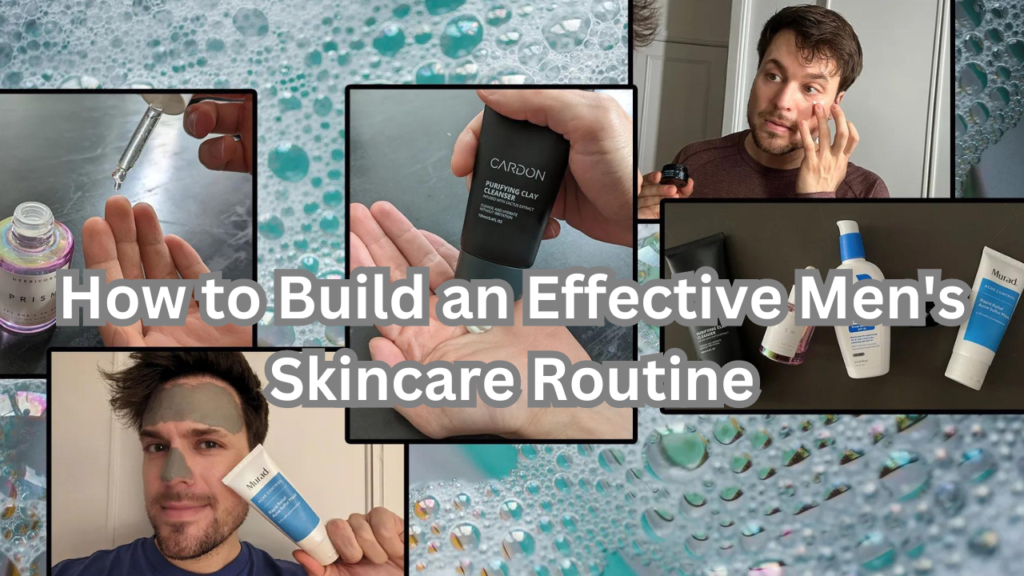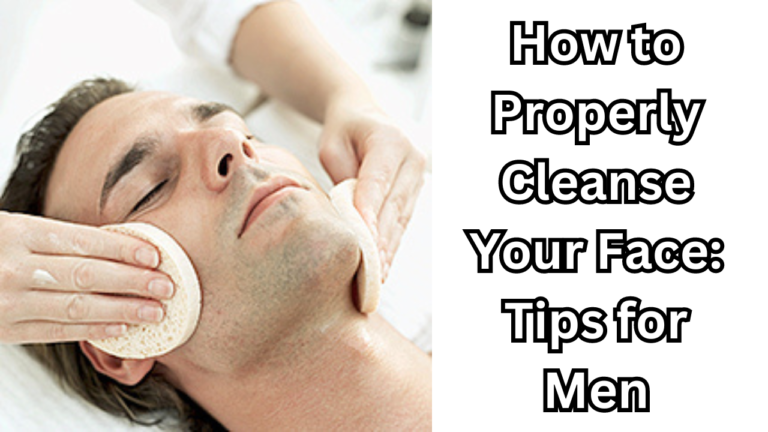

Table of Contents
Introduction
A well-structured skincare routine is essential for maintaining healthy, clear, and youthful-looking skin. For men, establishing a consistent regimen can help address common concerns such as acne, dryness, or signs of aging, while also improving overall skin health.
Incorporating key steps like cleansing, exfoliation, toning, moisturizing, and sun protection can significantly enhance your skin’s appearance and feel. This guide will walk you through the fundamental components of an Effective Men’s Skincare Routine, providing practical tips and recommendations to help you achieve your skincare goals. By following these steps, you can build a routine tailored to your skin’s needs and lifestyle.
Importance of a Skincare Routine
A skincare routine is vital for maintaining the health and appearance of your skin. Regular care helps manage various skin concerns such as acne, dryness, and premature aging, while also improving overall skin texture and clarity. By establishing a routine, you can:
- Prevent Skin Issues: Consistent cleansing and exfoliation help prevent clogged pores, breakouts, and other skin issues.
- Promote Healthy Skin: Regular moisturizing and sun protection keep your skin hydrated and shield it from UV damage, promoting a youthful appearance.
- Enhance Skin Appearance: A structured routine can improve skin tone, reduce fine lines, and make your skin look fresher and more vibrant.
Overview of Key Steps
- Cleansing: Start your routine with a gentle facial cleanser to remove dirt, oil, and impurities, preparing your skin for further treatment.
- Exfoliation: Use exfoliants to slough off dead skin cells and prevent clogged pores. This step helps reveal smoother, brighter skin.
- Toning: Apply a toner to balance your skin’s pH and tighten pores, helping to refine the texture and appearance of your skin.
- Moisturizing: Keep your skin hydrated with a moisturizer suited to your skin type. This step helps lock in moisture and maintain skin elasticity.
- Sun Protection: Protect your skin from harmful UV rays by applying a broad-spectrum sunscreen daily. This helps prevent sun damage and premature aging.
- Additional Treatments (Optional): Incorporate serums or eye creams for targeted concerns like dark spots or puffiness, enhancing your routine’s effectiveness.
Each step plays a crucial role in achieving and maintaining healthy skin, and together, they form a comprehensive approach to skincare.
Cleansing
Cleansing is the foundational step of any effective skincare routine. It’s essential for removing the day’s buildup of dirt, oil, and impurities from your skin, which helps prevent clogged pores, breakouts, and dullness. Here’s a breakdown of why cleansing is important and how to do it effectively:
Purpose of Cleansing
- Remove Dirt and Oil: Cleansing eliminates the natural oils and environmental pollutants that accumulate on your skin throughout the day, which can contribute to acne and other skin issues.
- Prevent Clogged Pores: Regular cleansing helps keep your pores clear by removing dead skin cells and debris, reducing the likelihood of breakouts.
- Prepare the Skin: Clean skin is more receptive to other skincare products, such as toners, moisturizers, and treatments, enhancing their effectiveness.
How-to: Cleansing
- Choose the Right Cleanser: Select a facial cleanser that suits your skin type:
- Oily Skin: Opt for a gel-based or foaming cleanser that helps control excess oil.
- Dry Skin: Use a cream-based or hydrating cleanser that won’t strip moisture from your skin.
- Combination Skin: A balanced cleanser that addresses both oily and dry areas can be beneficial.
- Use Lukewarm Water: Wash your face with lukewarm water to avoid irritation and dryness. Hot water can strip away essential oils, while cold water might not effectively dissolve impurities.
- Apply and Massage: Dispense a small amount of cleanser onto your fingertips and gently massage it onto your damp face using circular motions. Focus on areas that tend to be oilier or where dirt and debris accumulate.
- Rinse Thoroughly: Rinse your face thoroughly with lukewarm water, ensuring all cleanser is removed. Leftover product can cause irritation or contribute to clogged pores.
- Pat Dry: Gently pat your face dry with a clean towel. Avoid rubbing or scrubbing, as this can irritate your skin.
Tips for Effective Cleansing
- Frequency: Cleanse twice daily—once in the morning and once before bed—to keep your skin fresh and free of impurities.
- Avoid Over-Cleansing: Cleansing more than twice a day can strip your skin of its natural oils, leading to dryness or irritation.
- Use Clean Towels: Always use a clean towel or let your face air dry to avoid transferring bacteria and dirt.
By incorporating these practices into your skincare routine, you can achieve a clean, healthy complexion that serves as the perfect base for the rest of your skincare regimen.
Exfoliation
Exfoliation is a crucial step in maintaining a smooth, clear complexion. It involves removing dead skin cells from the surface of your skin to reveal fresher, healthier skin beneath. Here’s an overview of the importance of exfoliation and how to incorporate it into your routine effectively:
Purpose of Exfoliation
- Remove Dead Skin Cells: Exfoliation helps slough off dead skin cells that can cause dullness and lead to clogged pores.
- Prevent Clogged Pores: By clearing away debris and excess oil, exfoliation reduces the likelihood of acne and blackheads.
- Improve Skin Texture: Regular exfoliation can smooth rough patches and improve overall skin texture, making your skin look more even and radiant.
- Enhance Product Absorption: Removing dead cells allows other skincare products, such as serums and moisturizers, to penetrate more effectively.
How-to: Exfoliation
- Choose the Right Exfoliant: There are two main types of exfoliants:
- Physical Exfoliants: These contain abrasive particles (e.g., scrubs) that manually buff away dead skin cells. Choose a gentle scrub with fine particles to avoid irritation.
- Chemical Exfoliants: These use acids or enzymes (e.g., salicylic acid, glycolic acid) to dissolve dead skin cells. They are often less abrasive and can be more effective for deeper exfoliation.
- Frequency: Exfoliate 2-3 times a week, depending on your skin type and the exfoliant used. Over-exfoliating can lead to irritation and dryness, so it’s important to find a balance.
- Apply Gently: If using a physical exfoliant, apply it gently using circular motions. Avoid pressing too hard, as this can damage your skin. If using a chemical exfoliant, follow the product instructions for application.
- Rinse Thoroughly: Rinse your face thoroughly with lukewarm water to ensure all exfoliant residue is removed. Pat your face dry with a clean towel.
- Follow Up: After exfoliating, apply a moisturizer to help replenish any lost moisture and soothe your skin.
Tips for Effective Exfoliation
- Patch Test: Test new exfoliants on a small area of your skin to check for sensitivity or allergic reactions.
- Avoid Sensitive Areas: Be cautious around sensitive areas such as the eyes and avoid using physical exfoliants on broken or irritated skin.
- Hydrate: Exfoliate in conjunction with a good moisturizing routine to keep your skin hydrated and balanced.
Incorporating exfoliation into your skincare routine can significantly enhance the appearance and health of your skin, making it smoother, clearer, and more receptive to other treatments.
Toning
Toning is a vital step in a skincare routine that helps balance the skin’s pH, tighten pores, and prepare the skin for better absorption of subsequent products. Here’s a detailed look at the importance of toning and how to incorporate it into your routine effectively:
Purpose of Toning
- Balance Skin’s pH: Toning helps restore the skin’s natural pH balance, which can be disrupted by cleansing. This balance is crucial for maintaining healthy skin and preventing issues like excessive oiliness or dryness.
- Tighten Pores: Many toners contain astringent properties that can help tighten pores, giving the skin a smoother appearance.
- Remove Residual Impurities: Toning can remove any leftover traces of cleanser or impurities that may remain after washing your face.
- Prepare Skin for Moisturizer: By prepping your skin, toner enhances the absorption and effectiveness of subsequent skincare products, such as serums and moisturizers.
How-to: Toning
- Choose the Right Toner: Select a toner based on your skin type and concerns:
- Oily Skin: Look for toners with astringent properties or ingredients like witch hazel to help control oil and tighten pores.
- Dry Skin: Opt for hydrating toners with ingredients like glycerin or hyaluronic acid to add moisture and avoid stripping the skin.
- Sensitive Skin: Choose a soothing toner with calming ingredients like chamomile or aloe vera to avoid irritation.
- Application: After cleansing, apply the toner using one of the following methods:
- Cotton Pad: Soak a cotton pad with toner and gently swipe it over your face, avoiding the eye area.
- Hands: You can also dispense a small amount of toner into your palms and pat it onto your face.
- Allow to Dry: Let the toner absorb into your skin and dry naturally. This will ensure that your skin fully benefits from the toner’s properties.
- Follow Up: After the toner has dried, proceed with your next skincare steps, such as applying serums and moisturizers.
Tips for Effective Toning
- Avoid Alcohol-Based Toners: Many traditional toners contain alcohol, which can be drying and irritating. Opt for alcohol-free formulas to keep your skin hydrated and balanced.
- Check Ingredients: Look for toners that include beneficial ingredients like antioxidants, hydration boosters, or calming agents that suit your skin’s needs.
- Use Consistently: Incorporate toning into your daily skincare routine, ideally both morning and evening, to maintain balanced and healthy skin.
By integrating a toner into your skincare men, you can achieve a well-balanced, refreshed complexion that sets the stage for optimal results from your other skincare products.
Moisturizing
Moisturizing is a key component of a skincare routine that helps maintain skin hydration, protect the skin barrier, and improve overall skin texture. Properly moisturizing your skin can prevent dryness, reduce the appearance of fine lines, and keep your skin looking healthy and vibrant. Here’s a comprehensive guide to understanding and implementing effective moisturizing:
Purpose of Moisturizing
- Hydrate the Skin: Moisturizers help replenish and lock in moisture, preventing dryness and keeping your skin soft and supple.
- Protect the Skin Barrier: A good moisturizer forms a protective layer on the skin, helping to shield it from environmental factors and reduce moisture loss.
- Improve Skin Texture: Regular use of a moisturizer can smooth rough patches, reduce flakiness, and enhance the overall texture of your skin.
- Reduce Fine Lines: Hydrated skin is more resilient and plump, which can help diminish the appearance of fine lines and wrinkles.
How-to: Moisturizing
- Choose the Right Moisturizer: Select a moisturizer based on your skin type and concerns:
- Oily Skin: Opt for a lightweight, oil-free, or gel-based moisturizer that hydrates without adding excess oil.
- Dry Skin: Choose a richer, cream-based moisturizer with ingredients like hyaluronic acid, ceramides, or shea butter to provide deep hydration.
- Combination Skin: A balanced, non-comedogenic moisturizer can address both oily and dry areas without causing breakouts.
- Apply to Clean Skin: After cleansing and toning, apply your moisturizer to your face and neck. Ensure your skin is still slightly damp to help lock in moisture.
- Use Gentle Motions: Apply the moisturizer using upward, gentle strokes. Avoid rubbing or tugging at the skin to prevent irritation.
- Frequency: Use a moisturizer twice daily—once in the morning and once before bed—to maintain consistent hydration levels.
Tips for Effective Moisturizing
- Don’t Skip SPF: During the day, choose a moisturizer with SPF to combine hydration with sun protection. This helps protect your skin from UV damage and prevents premature aging.
- Adjust Seasonally: Your moisturizing needs may change with the seasons. For instance, you might need a heavier moisturizer in winter and a lighter one in summer.
- Patch Test New Products: Always test new moisturizers on a small area of your skin to ensure you don’t have an adverse reaction.
By incorporating a suitable moisturizer into your skincare routine, you can maintain hydrated, healthy, and well-protected skin, ensuring that your complexion remains balanced and radiant.
Sun Protection
Sun protection is a crucial aspect of any skincare routine, as it helps safeguard your skin from the harmful effects of ultraviolet (UV) radiation. Proper sun protection can prevent sunburn, premature aging, and reduce the risk of skin cancer. Here’s a detailed guide to understanding and applying effective sun protection:
Purpose of Sun Protection
- Prevent UV Damage: UV rays from the sun can cause damage to the skin cells, leading to issues such as sunburn, dark spots, and premature aging.
- Reduce Premature Aging: Regular sun protection helps prevent wrinkles, fine lines, and loss of skin elasticity caused by UV exposure.
- Lower Skin Cancer Risk: Using sunscreen reduces the risk of developing skin cancer, including melanoma, by shielding the skin from harmful UV radiation.
- Maintain Even Skin Tone: Sun protection helps prevent hyperpigmentation and uneven skin tone caused by UV exposure.
How-to: Sun Protection
- Choose the Right Sunscreen: Select a broad-spectrum sunscreen with an SPF (Sun Protection Factor) of at least 30. Broad-spectrum sunscreens protect against both UVA and UVB rays.
- For Oily Skin: Opt for a lightweight, oil-free, or gel-based sunscreen.
- For Dry Skin: Choose a sunscreen with hydrating ingredients like hyaluronic acid or glycerin.
- For Sensitive Skin: Look for sunscreens with calming ingredients and without potential irritants like alcohol or fragrances.
- Apply Generously: Apply sunscreen generously to all exposed skin areas, including the face, neck, ears, and any other areas not covered by clothing. Use about a nickel-sized amount for your face.
- Timing: Apply sunscreen 15-30 minutes before sun exposure to allow it to fully absorb and provide optimal protection. Reapply every two hours, or more frequently if swimming or sweating.
- Daily Use: Incorporate sunscreen into your daily skincare routine, even on cloudy days or when staying indoors, as UV rays can penetrate windows and affect your skin.
Tips for Effective Sun Protection
- Don’t Rely Solely on Sunscreen: Complement sunscreen with additional sun protection measures, such as wearing protective clothing, hats, and sunglasses, and seeking shade during peak sun hours (10 a.m. to 4 p.m.).
- Check Expiration Dates: Ensure your sunscreen is not expired, as its effectiveness can diminish over time.
- Reapply After Water Exposure: If you’re swimming or sweating, use water-resistant sunscreen and reapply it according to the product instructions.
By consistently using sun protection, you can help maintain healthy skin, prevent signs of aging, and reduce your risk of skin cancer, ensuring your skin remains in optimal condition for years to come.
Lifestyle Factors
In addition to a consistent skincare routine, various lifestyle factors play a significant role in maintaining healthy, radiant skin. These factors contribute to overall skin health and can enhance the effectiveness of your skincare regimen. Here’s a look at key lifestyle considerations that impact your skin:
1. Hydration
- Importance: Drinking plenty of water helps keep your skin hydrated from the inside out. Proper hydration supports skin elasticity, reduces dryness, and can contribute to a healthier complexion.
- Tips: Aim to drink at least 8 glasses (about 2 liters) of water daily. Adjust your intake based on factors like activity level, climate, and individual needs.
2. Diet
- Importance: A balanced diet rich in vitamins, minerals, and antioxidants can positively impact your skin’s appearance and health. Nutrient-rich foods support skin repair, reduce inflammation, and enhance skin radiance.
- Tips: Incorporate a variety of fruits, vegetables, whole grains, lean proteins, and healthy fats into your diet. Foods high in vitamins A, C, and E, as well as omega-3 fatty acids, are particularly beneficial for skin health.
3. Sleep
- Importance: Quality sleep is essential for skin regeneration and repair. During sleep, your skin undergoes repair processes that help maintain its health and appearance.
- Tips: Aim for 7-8 hours of uninterrupted sleep each night. Establish a consistent sleep schedule and create a restful sleep environment to improve sleep quality.
4. Stress Management
- Importance: Chronic stress can negatively impact your skin, leading to issues such as acne, eczema, or premature aging. Managing stress effectively supports overall well-being and skin health.
- Tips: Practice stress-reducing techniques such as mindfulness, meditation, exercise, or hobbies. Find activities that help you relax and unwind.
5. Exercise
- Importance: Regular physical activity improves blood circulation, which helps deliver essential nutrients and oxygen to your skin. Exercise also supports the removal of toxins through sweating.
- Tips: Aim for at least 30 minutes of moderate exercise most days of the week. Choose activities you enjoy, such as walking, jogging, or yoga.
6. Avoid Smoking and Excessive Alcohol Consumption
- Importance: Smoking and excessive alcohol consumption can have detrimental effects on your skin, including premature aging, dryness, and dullness.
- Tips: If you smoke, consider seeking support to quit. Limit alcohol intake to moderate levels (up to one drink per day for men) and drink plenty of water to stay hydrated.
7. Sun Protection
- Importance: As previously mentioned, protecting your skin from UV damage is crucial for preventing sunburn, premature aging, and skin cancer.
- Tips: Apply sunscreen daily, wear protective clothing, and avoid excessive sun exposure.
By integrating these lifestyle factors into your daily routine, you can enhance your skincare efforts and promote overall skin health. A holistic approach that includes proper hydration, a balanced diet, adequate sleep, stress management, and healthy habits will support a glowing, resilient complexion.
Tips for Success
Building and maintaining an Effective Men’s Skincare Routine involves more than just following the basic steps. Here are some additional tips to help you achieve the best results and make your skincare routine as effective as possible:
Be Consistent
- Stick to Your Routine: Consistency is key to seeing long-term benefits from your skincare routine. Adhere to your regimen daily and avoid skipping steps to achieve the best results.
- Set a Routine: Establish a morning and evening skincare routine to create a habit and ensure that you don’t miss any steps.
Understand Your Skin Type
- Know Your Skin: Determine your skin type (oily, dry, combination, sensitive) and tailor your products and routine to meet your specific needs.
- Adjust Seasonally: Be mindful of changes in your skin due to seasonal shifts and adjust your products accordingly.
Use Products as Directed
- Follow Instructions: Adhere to the usage instructions provided with each product to avoid overuse or misuse, which can lead to irritation or decreased effectiveness.
- Layer Products Correctly: Apply skincare products in the correct order (e.g., cleanse, tone, treat, moisturize) to ensure they work effectively.
Patch Test New Products
- Prevent Reactions: Test new products on a small area of your skin before applying them to your entire face to check for any adverse reactions or allergies.
Avoid Over-Exfoliating
- Moderation is Key: Exfoliate 2-3 times a week as over-exfoliation can lead to irritation and damage to your skin barrier. Adjust frequency based on your skin’s response.
Stay Hydrated
- Internal Hydration: Drink plenty of water throughout the day to support your skin’s hydration levels from within.
Protect Your Skin from the Sun
- Daily Sunscreen: Apply sunscreen every morning, even on cloudy days, and reapply as needed. Sun protection is crucial for preventing sun damage and premature aging.
Maintain a Healthy Lifestyle
- Balanced Diet: Eat a nutrient-rich diet to support your skin’s health and appearance.
- Regular Exercise: Engage in regular physical activity to improve circulation and overall skin health.
- Manage Stress: Use stress management techniques to minimize its impact on your skin.
Be Patient
- Allow Time for Results: Skincare improvements often take time. Be patient and give products time to work before making changes to your routine.
Consult Professionals
- Seek Expert Advice: If you have persistent skin concerns or conditions, consult a dermatologist or skincare professional for personalized advice and treatment.
By following these tips, you can optimize your skincare routine, address your skin’s unique needs, and achieve a healthier, more radiant complexion.
Conclusion
An Effective Men’s Skincare Routine is a powerful tool for achieving and maintaining healthy, vibrant skin. By incorporating essential steps such as cleansing, exfoliation, toning, moisturizing, and sun protection, you can address various skin concerns, enhance your complexion, and promote overall skin health.
Consistency, understanding your skin type, and using products as directed are key to seeing the best results. Additionally, integrating lifestyle factors such as proper hydration, a balanced diet, regular exercise, and stress management can further support and enhance your skincare efforts.
Remember that skincare is a journey, not a destination. Be patient and give your routine time to show its benefits. If you encounter persistent issues or need personalized advice, don’t hesitate to consult a skincare professional.
By following these guidelines and tips, you can build a skincare routine that not only improves your skin’s appearance but also contributes to your overall well-being and confidence.
Recap of Steps
To build an Effective Men’s Skincare Routine, follow these essential steps:
- Cleansing: Begin with a facial cleanser to remove dirt, oil, and impurities. Choose a cleanser that suits your skin type and cleanse twice daily—morning and evening.
- Exfoliation: Exfoliate 2-3 times a week to slough off dead skin cells and prevent clogged pores. Use either a physical or chemical exfoliant based on your skin’s needs.
- Toning: Apply a toner to balance your skin’s pH, tighten pores, and remove any residual impurities. Opt for a formula that complements your skin type.
- Moisturizing: Keep your skin hydrated with a moisturizer appropriate for your skin type. Use it twice daily to maintain moisture and support your skin’s barrier.
- Sun Protection: Apply a broad-spectrum sunscreen with at least SPF 30 every morning, even on cloudy days, to protect your skin from UV damage and premature aging.
- Additional Treatments (Optional): Incorporate serums or eye creams for specific concerns such as dark spots or puffiness, if desired.
Encouragement to Start Building a Routine
Building a skincare routine might seem like a small change, but it can have a significant impact on your overall skin health and appearance. Starting with these fundamental steps will set you on the path to achieving clearer, healthier, and more youthful skin.
Don’t be discouraged if you don’t see immediate results—consistency is key. By integrating these steps into your daily life, you’ll develop habits that support your skin’s well-being and enhance your confidence.
Take the first step today by selecting the right products and committing to your routine. Your future self will thank you for the care and attention you invest in your skin now.





